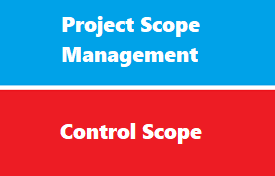introduction
this article to discuss the sixth and last process of scope management which is control scope
Control Scope is the process of monitoring the status of the project and product scope and managing changes to the scope baseline. The key benefit of this process is that it allows the scope baseline to be maintained throughout the project.
control scope process concepts
control Scope Concepts
control scope ensure that that all change request including corrective action and preventive action are proceed through ICC integrated change control
also control scope used to manage change when it accrued
uncontrolled expansion of scope or time or cost is called scope creep
Prerequisites of Control Scope Process
In Control scope process there are two main prerequisites before controlling the scope:
- The first prerequisite is that the scope definition must be clear. Because scope performance measurement will be done mainly on the sealed scope in the beginning. To do accurate and precise scope performance measurement, the scope definition must be clear.
- The second prerequisite is that the work must be completed. In order to check the results of a delivered work against the scope baseline, it must be finished first.
Control Scope : inputs-tolls-Techniques-Outputs
Inputs
- pm plan
- requirement documentation
- requirement traceability matrix
- work performance data
- OPA
technique
- variance analysis
Outputs
- work performance information
- change request
- update pm plan
- update project documents
- update OPA
Control Scope inputs.
There are five inputs to the control scope process:
Project management plan.
This contains the scope baseline consisting of the WBS codes WBS dictionary as well as the project scope statement. It contains the scope management plan describing how control scope will occur as well as the change control plan describing the project change control system.
The project management plan also contains the configuration management plan describing how the physical elements of the product will be controlled, and the requirements management plan describing how the project requirements will be managed and controlled.
Work performance information.
This provides information on deliverable status and describes which deliverables are complete, which are currently ‘work in progress’, and how much work remains. It will typically also include any issues, problems or risks that the development team is dealing with for particular deliverables or products.
Requirements documentation.
This is particularly useful as an input because whenever a change request is raised or detected, the requirements documentation acts as a reference to understand what was originally agreed so that the change can be evaluated against the backdrop of the regional requirement.
Requirements traceability matrix.
This helps the project manager to a value weights potential changes and change requests with regard to the original requirement. It also helps to identify the source of each requirement select the appropriate stakeholders can be involved and consulted as is appropriate.
Organizational process assets.
This will normally cover any particular policies and procedures that have been laid down by the delivery organization regarding scope management.
As a consequence of scope, one of the tools is variance analysis where the causes of such variances and lessons learned are documented. This may cause change requests possibly for taking corrective or preventative actions, or maybe defect repair.
The upshot of this is normally that the scope baseline will need to be updated and that will normally mean schedule and cost baselines need you to change as well.
The Control Scope tool.
There is only one tool used within the control scope process:
Variance analysis.
This is used to measure any such differences between what was originally defined within the scope baseline verses what was actually created, and this is a very effective way to investigate the root causes behind such differences.
In summary, to control scope, you will want to compare the baseline and requirements with the current actual results by conducting variance analysis. If a variance exists then a change requests should be sublimated. As a result of this work performance measurements will be created along with a updates to the project management plan, documentation and organizational process assets.
Control Scope outputs.
There are five outputs from the control scope process:
Work performance measurements.
These will show how actual progress is different from the original plan and such measurements are collected as part of the control scope process is used by the communications process, report performance.
Organizational process assets updates.
Whenever any form of corrective action is implemented, it is highly likely that changes will also need to be made to any organizational process assets, is clearly they were not entirely adequate this time, and will need to be updated for future projects.
Change requests.
If any changes are made to the scope baseline, then these must be incorporated as updates to the WBS. If such a change results in enhancing the original scope, then this two must be decomposed down to the level of work packages, causing additional changes to other documentation.
Project management plan updates.
As already stated, any change in scope will need to be updated within the project management plan because of resulting changes in potentially cost, schedule, risk, quality, ect.
Project document updates.
Similar to the above examples, there may be other documentation that needs to be updated for example the risk log or regular reports.


